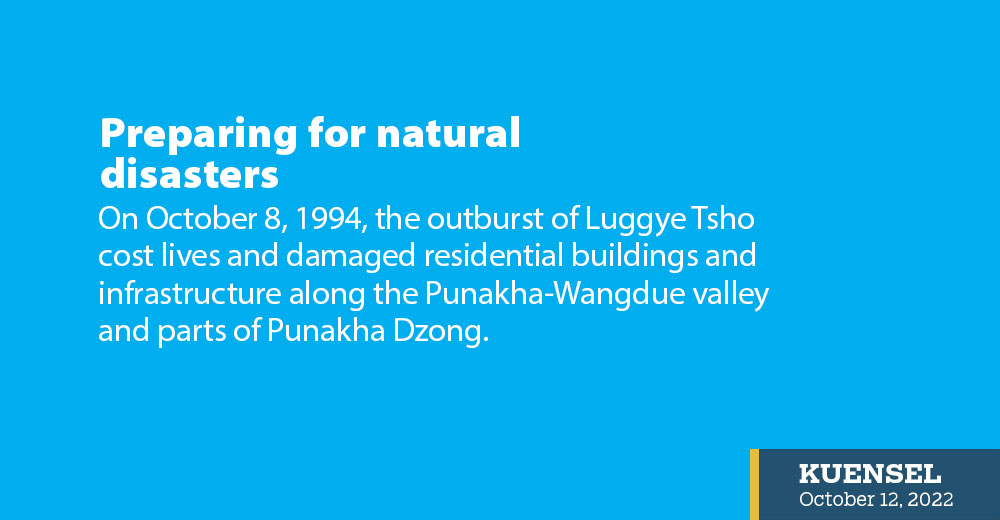Chhimi Dema
On October 8, 1994, the outburst of Luggye Tsho cost lives and damaged residential buildings and infrastructure along the Punakha-Wangdue valley and parts of Punakha Dzong.
Twenty-eight years after the event, the country faces the threat of more such dangers—particularly glacial lake outbursts (GLOFs).
The Department of Disaster Management (DDM), therefore, is creating awareness among the people.
DDM’s chief, Thinley Norbu, said that people should understand the risk and the coping capacity of the population and infrastructure for disaster reduction.
Risks are assessed and response plans made, he said. “If people do not understand the risk of a hazard, then they won’t be able to cope during a disaster.”
For disaster management, creating awareness is critical as people are the first responders, Thinley Norbu said.
Disaster management can be understood in four cycles—mitigation, preparedness, response, and recovery.
For example, in the event of an earthquake, mitigation involves structural designs, policies, and governance. Preparedness and response cycles are the assessment of a disaster’s impact and identifying the roles of agencies to respond to the impacts. Recovery is the start of developmental activities.
DDM as an agency to oversee disaster issues in the country delivers coordination and facilitates services in disaster management and works towards helping government and other stakeholders attain disaster resilience.
The department is currently carrying out awareness programmes on disaster reduction in corporate offices and non-structural measures at home.
DDM is working with government agencies such as the Ministry of Works and Human Settlement, the National Centre for Hydrology and Meteorology, and the National Land Commission to develop a disaster risk management portal that will generate science and evidence-based hazard mapping.
The portal will help in drawing customised hazard-mapping based on a community’s vulnerability.
The country has identified earthquakes as the number one disaster.
The available records show that there were 29 earthquake events in Bhutan and neighbouring countries that had varying degrees of impact on lives and infrastructures.
The recent earthquake was on April 28 last year in Assam which caused injuries to people and damaged religious monuments, school buildings and houses.
DDM has made disaster management contingency plans that comprise activities that the local governments can carry out in case of a disaster. These plans are based on a historical approach or evidence of a disaster in the area. With the DRM portal, the plans will be science-based and customised to locations for different hazards.
According to Thinley Norbu, a challenge today is the lack of institutionalised channels to disseminate information.
October 13 is the International Day for Disaster Risk Reduction. This year’s international day will focus on “Substantially increasing the availability of and access to multi-hazard early warning systems and disaster risk information and assessments to people by 2030.”


